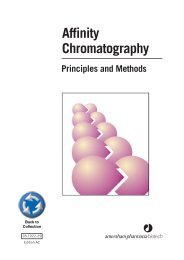THE NERVOUS SYSTEM
THE NERVOUS SYSTEM
THE NERVOUS SYSTEM
You also want an ePaper? Increase the reach of your titles
YUMPU automatically turns print PDFs into web optimized ePapers that Google loves.
<strong>THE</strong> <strong>NERVOUS</strong> <strong>SYSTEM</strong>
• Brain<br />
WHAT PARTS DO YOU KNOW THAT<br />
ARE IN <strong>THE</strong> <strong>NERVOUS</strong> <strong>SYSTEM</strong><br />
• Spinal Cord<br />
• Peripheral Nerves
What makes up the brain, the spinal cord or<br />
• Neurons are “the cell”<br />
• Cell body<br />
• Nucleus<br />
• Axon<br />
• Dendrite<br />
• What do you think<br />
surrounds the cell<br />
• What other organelles<br />
would be needed<br />
your peripheral nerves
How are neurons connected<br />
• Synapses!!
Why are neurons connected
More neuron connections!
Close up look at your synapse<br />
AXON<br />
The synapse -<br />
where the action<br />
happens<br />
The next cell’s plasma<br />
membrane<br />
What is this<br />
in the<br />
membrane<br />
Transport<br />
protein
How does the Synapse carry the signal<br />
1. Electrical current travels down the axon<br />
2. Vesicles with chemicals move toward the membrane - what is<br />
that called<br />
3. Chemicals are released and diffuse toward the next cell’s<br />
plasma membrane<br />
4. The chemicals open up the transport proteins and allow the<br />
signal to pass to the next cell - what type of diffusion is this
The synapse carries a signal from cell to cell<br />
1<br />
2<br />
3 4
There are lots of proteins and chemicals in your<br />
body to do the work<br />
Why is it important that it is an electrical current
Are all neurons equal in size<br />
• Brain vs spinal cord vs peripheral nerves<br />
About how many neurons are in the human brain<br />
About how many neurons are in the spinal cord<br />
How long do you think the longest axon in the world is<br />
100 billion<br />
1 billion<br />
around 15 feet
How many synapses<br />
are in one neuron<br />
1,000 to 10,000!!
This science is called Neurobiology<br />
• Looking at the actual cells - how do they work<br />
• Looking at the connections - how and when do they work<br />
• Looking at what can change normal cells and connections<br />
• Looking at diseases that occur in the brain<br />
• One of the largest areas still unknown<br />
• The you that is you is because of your neurons connecting!
What do you think can change<br />
neurons and their connections<br />
• Accidents<br />
• Drugs<br />
• Alcohol<br />
• Disease
Accidents<br />
• Physical injury of your neurons
Drugs and alcohol bind important receptors on neurons
Repeated binding causes the neuron to die
Drugs = neuron death
Alcohol damages dendrites - can<br />
repair after abstinence<br />
Alcohol blocks<br />
receptors and slows<br />
down transmission
•Parkinson's Disease<br />
•ALS - Lou Gehrig’s Disease<br />
•Huntington’s Disease<br />
•Multiple Sclerosis<br />
•Alzheimer's<br />
•Cerebral Palsy<br />
•Epilepsy<br />
• SIDS
100 Billion or so neurons - what’s the<br />
problem with some of them dying<br />
•Cells multiply all the time<br />
- will your neurons<br />
•Does everyone react the<br />
same way to accidents, or<br />
drugs and alcohol<br />
•Do all organisms react the<br />
same to all stimulus<br />
•Which of your activities<br />
use your neurons
What if<br />
neurons die<br />
here<br />
or here<br />
or here<br />
or here<br />
or here
Neurobiology Activities and Labs<br />
• What Does Your "Homunculus" Look Like<br />
(www.accessexcellence.org/AE/AEPC/WWC/1991/homunculus.html)<br />
• Effect of Environment on Memory<br />
(http://www.accessexcellence.org/AE/AEC/AEF/1996/brown_memory<br />
.html)<br />
• Taste Activity<br />
(http://yucky.kids.discovery.com/flash/fun_n_games/activities/experim<br />
ents/experiment_truly_tasteless.html)<br />
• A healthy brain - Caffeine activity<br />
(http://www.pfizer.com/brain/teachers_html.html)<br />
• Pillbug behavior Lab - (http://www.udel.edu/msmith/pillbugs.html)
REFERENCES<br />
• http://faculty.washington.edu/chudler/facts.html<br />
• http://occawlonline.pearsoned.com/bookbind/pubbooks/campbell6e_awl/chapter0<br />
/deluxe.html<br />
• JOSHSANESPPT.PPT<br />
• www.alfamilyties.org/presentations/The%20Neurobiology%20of%20Adole<br />
scent%20Substance%20Abuse%20II.ppt<br />
• http://www.nsbri.org/Education/High_Act.html<br />
• http://www.pfizer.com/brain/teachers_html.html<br />
• http://www.research.buffalo.edu/quarterly/vol10/num01/n1.shtml<br />
• http://www.aim-digest.com/gateway/pages/brain/articles/myths.htm<br />
• http://www.nida.nih.gov/pubs/teaching/Teaching5/Teaching3.html<br />
• http://www.accessexcellence.com/AE/<br />
• http://psych.colorado.edu/~kenth/Image14.gif
















